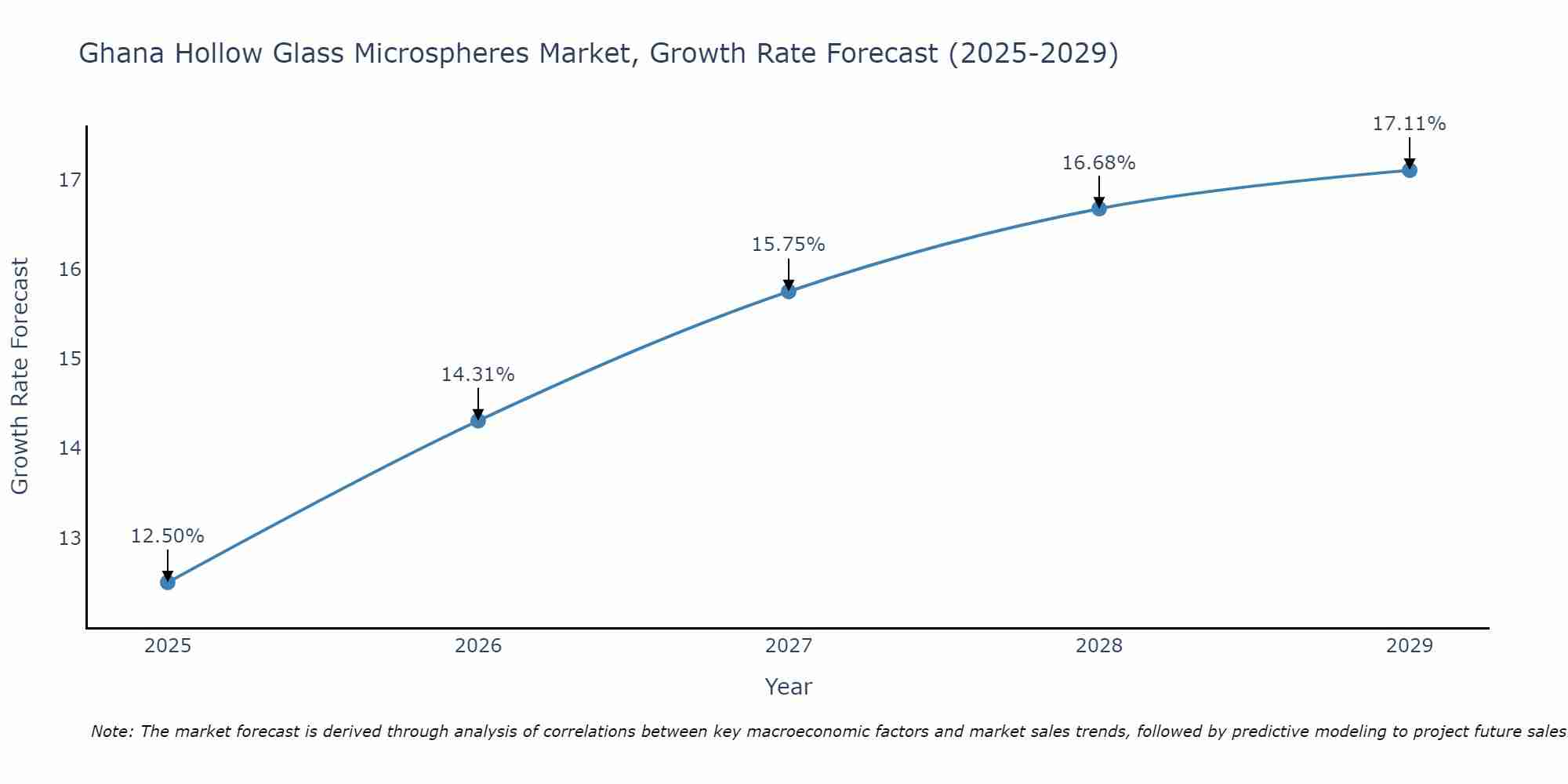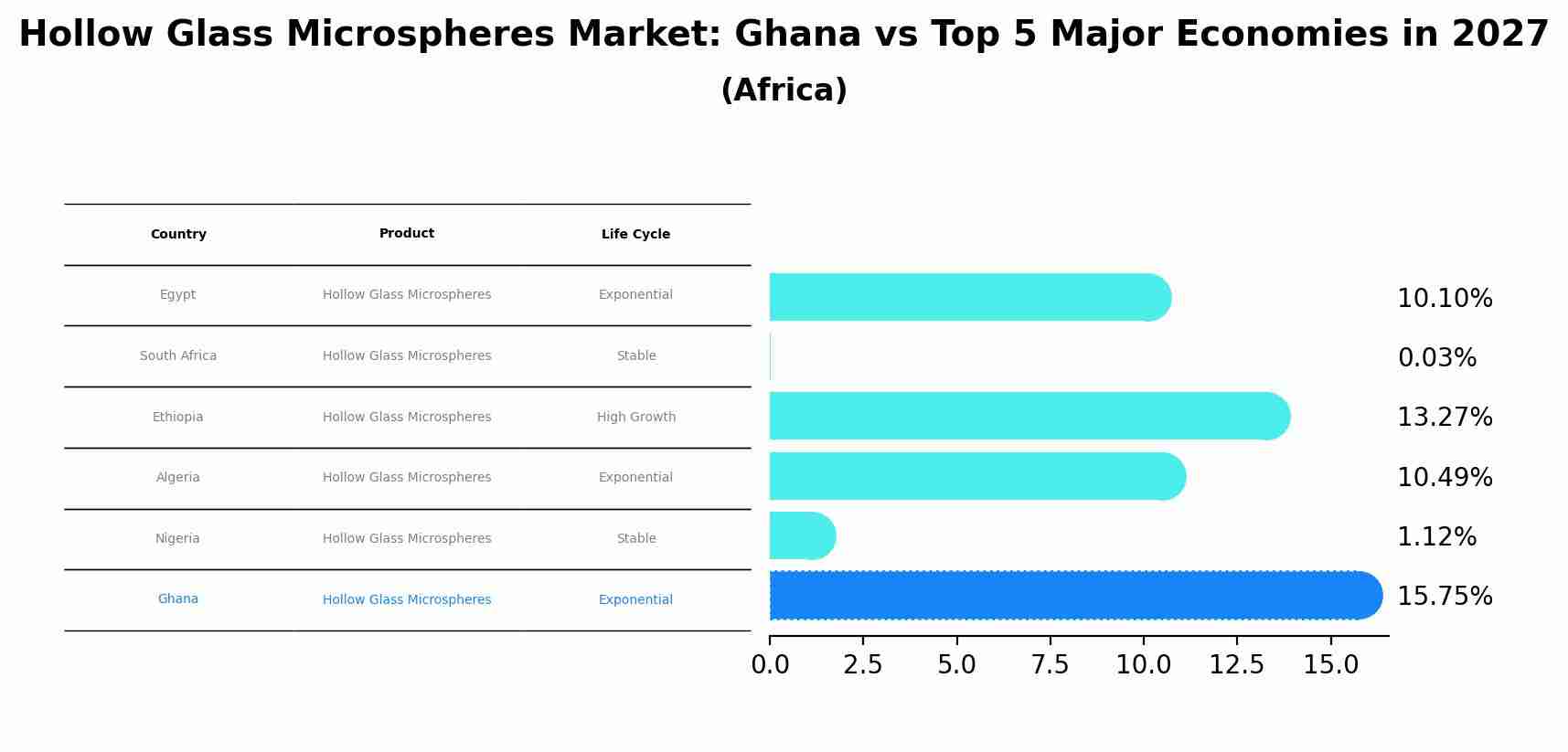Ghana Hollow Glass Microspheres Market (2025-2031) Outlook | Trends, Industry, Analysis, Size, Growth, Companies, Forecast, Share, Revenue & Value
| Product Code: ETC214748 | Publication Date: May 2022 | Updated Date: Aug 2025 | Product Type: Market Research Report | |
| Publisher: 6Wresearch | Author: Ravi Bhandari | No. of Pages: 60 | No. of Figures: 40 | No. of Tables: 7 |
Ghana Hollow Glass Microspheres Market Size Growth Rate
The Ghana Hollow Glass Microspheres Market is poised for steady growth rate improvements from 2025 to 2029. Commencing at 12.50% in 2025, growth builds up to 17.11% by 2029.

Hollow Glass Microspheres Market: Ghana vs Top 5 Major Economies in 2027 (Africa)
By 2027, Ghana's Hollow Glass Microspheres market is forecasted to achieve a exponential growth rate of 15.75%, with Egypt leading the Africa region, followed by South Africa, Ethiopia, Algeria and Nigeria.

Ghana Hollow Glass Microspheres Market Overview
The Ghana hollow glass microspheres market involves the production and utilization of lightweight filler materials for various applications such as composites, coatings, and insulation products. In Ghana, hollow glass microspheres offer advantages such as low density, high strength, and thermal insulation properties, driving demand in industries such as aerospace, automotive, construction, and oil and gas for lightweight and high-performance materials.
Drivers of the market
The Ghana hollow glass microspheres market is experiencing growth propelled by the increasing demand for lightweight fillers, insulation materials, and additive manufacturing components in various industries such as construction, automotive, and aerospace. Hollow glass microspheres, also known as glass bubbles or microballoons, offer advantages such as low density, high strength, and thermal insulation properties for enhancing the performance of composites, coatings, and polymer formulations. Factors such as lightweighting initiatives, energy efficiency requirements, and sustainability trends are driving the adoption of hollow glass microspheres in Ghana. Moreover, advancements in glass manufacturing technology, material formulations, and product applications are further fueling market growth in the country.
Challenges of the market
One of the main challenges facing the hollow glass microspheres market in Ghana is the need for technological advancements to enhance the properties and performance of microspheres in various applications such as lightweight fillers and insulation materials. Additionally, ensuring quality control and product consistency pose challenges for manufacturers. Moreover, addressing cost constraints and market competitiveness may hinder the adoption of hollow glass microspheres in Ghana construction and industrial sectors.
Government Policy of the market
Recognizing the potential applications of hollow glass microspheres in lightweight materials, insulation, and composites, the government of Ghana has implemented policies to promote research, innovation, and industrial collaboration in this emerging market. These policies include incentives for technology development and commercialization, support for partnerships between research institutions and private enterprises, and efforts to integrate hollow glass microspheres into sustainable construction, transportation, and manufacturing processes to enhance efficiency and reduce environmental impact.
Key Highlights of the Report:
- Ghana Hollow Glass Microspheres Market Outlook
- Market Size of Ghana Hollow Glass Microspheres Market, 2024
- Forecast of Ghana Hollow Glass Microspheres Market, 2031
- Historical Data and Forecast of Ghana Hollow Glass Microspheres Revenues & Volume for the Period 2021-2031
- Ghana Hollow Glass Microspheres Market Trend Evolution
- Ghana Hollow Glass Microspheres Market Drivers and Challenges
- Ghana Hollow Glass Microspheres Price Trends
- Ghana Hollow Glass Microspheres Porter's Five Forces
- Ghana Hollow Glass Microspheres Industry Life Cycle
- Historical Data and Forecast of Ghana Hollow Glass Microspheres Market Revenues & Volume By Type for the Period 2021-2031
- Historical Data and Forecast of Ghana Hollow Glass Microspheres Market Revenues & Volume By Glass for the Period 2021-2031
- Historical Data and Forecast of Ghana Hollow Glass Microspheres Market Revenues & Volume By Others for the Period 2021-2031
- Historical Data and Forecast of Ghana Hollow Glass Microspheres Market Revenues & Volume By Application for the Period 2021-2031
- Historical Data and Forecast of Ghana Hollow Glass Microspheres Market Revenues & Volume By Automotive for the Period 2021-2031
- Historical Data and Forecast of Ghana Hollow Glass Microspheres Market Revenues & Volume By Aerospace & Defense for the Period 2021-2031
- Historical Data and Forecast of Ghana Hollow Glass Microspheres Market Revenues & Volume By Building & Construction for the Period 2021-2031
- Historical Data and Forecast of Ghana Hollow Glass Microspheres Market Revenues & Volume By Paints & Coatings for the Period 2021-2031
- Historical Data and Forecast of Ghana Hollow Glass Microspheres Market Revenues & Volume By Electrical & Electronics for the Period 2021-2031
- Historical Data and Forecast of Ghana Hollow Glass Microspheres Market Revenues & Volume By Cosmetics & Personal Care for the Period 2021-2031
- Historical Data and Forecast of Ghana Hollow Glass Microspheres Market Revenues & Volume By Healthcare for the Period 2021-2031
- Ghana Hollow Glass Microspheres Import Export Trade Statistics
- Market Opportunity Assessment By Type
- Market Opportunity Assessment By Application
- Ghana Hollow Glass Microspheres Top Companies Market Share
- Ghana Hollow Glass Microspheres Competitive Benchmarking By Technical and Operational Parameters
- Ghana Hollow Glass Microspheres Company Profiles
- Ghana Hollow Glass Microspheres Key Strategic Recommendations
Frequently Asked Questions About the Market Study (FAQs):
1 Executive Summary |
2 Introduction |
2.1 Key Highlights of the Report |
2.2 Report Description |
2.3 Market Scope & Segmentation |
2.4 Research Methodology |
2.5 Assumptions |
3 Ghana Hollow Glass Microspheres Market Overview |
3.1 Ghana Country Macro Economic Indicators |
3.2 Ghana Hollow Glass Microspheres Market Revenues & Volume, 2021 & 2031F |
3.3 Ghana Hollow Glass Microspheres Market - Industry Life Cycle |
3.4 Ghana Hollow Glass Microspheres Market - Porter's Five Forces |
3.5 Ghana Hollow Glass Microspheres Market Revenues & Volume Share, By Type, 2021 & 2031F |
3.6 Ghana Hollow Glass Microspheres Market Revenues & Volume Share, By Application, 2021 & 2031F |
4 Ghana Hollow Glass Microspheres Market Dynamics |
4.1 Impact Analysis |
4.2 Market Drivers |
4.2.1 Increasing demand for lightweight materials in various industries such as construction, automotive, and aerospace. |
4.2.2 Growing emphasis on energy efficiency and sustainability, driving the adoption of hollow glass microspheres in insulation and composites. |
4.2.3 Technological advancements leading to the development of innovative applications for hollow glass microspheres. |
4.3 Market Restraints |
4.3.1 High production costs associated with manufacturing hollow glass microspheres. |
4.3.2 Limited awareness and understanding of the benefits of hollow glass microspheres among end-users. |
4.3.3 Availability of substitute materials impacting the market growth. |
5 Ghana Hollow Glass Microspheres Market Trends |
6 Ghana Hollow Glass Microspheres Market, By Types |
6.1 Ghana Hollow Glass Microspheres Market, By Type |
6.1.1 Overview and Analysis |
6.1.2 Ghana Hollow Glass Microspheres Market Revenues & Volume, By Type, 2021-2031F |
6.1.3 Ghana Hollow Glass Microspheres Market Revenues & Volume, By Glass, 2021-2031F |
6.1.4 Ghana Hollow Glass Microspheres Market Revenues & Volume, By Others, 2021-2031F |
6.2 Ghana Hollow Glass Microspheres Market, By Application |
6.2.1 Overview and Analysis |
6.2.2 Ghana Hollow Glass Microspheres Market Revenues & Volume, By Automotive, 2021-2031F |
6.2.3 Ghana Hollow Glass Microspheres Market Revenues & Volume, By Aerospace & Defense, 2021-2031F |
6.2.4 Ghana Hollow Glass Microspheres Market Revenues & Volume, By Building & Construction, 2021-2031F |
6.2.5 Ghana Hollow Glass Microspheres Market Revenues & Volume, By Paints & Coatings, 2021-2031F |
6.2.6 Ghana Hollow Glass Microspheres Market Revenues & Volume, By Electrical & Electronics, 2021-2031F |
6.2.7 Ghana Hollow Glass Microspheres Market Revenues & Volume, By Cosmetics & Personal Care, 2021-2031F |
7 Ghana Hollow Glass Microspheres Market Import-Export Trade Statistics |
7.1 Ghana Hollow Glass Microspheres Market Export to Major Countries |
7.2 Ghana Hollow Glass Microspheres Market Imports from Major Countries |
8 Ghana Hollow Glass Microspheres Market Key Performance Indicators |
8.1 Research and development investment in new applications and technologies for hollow glass microspheres. |
8.2 Number of partnerships and collaborations with key industry players to expand market reach. |
8.3 Adoption rate of hollow glass microspheres in emerging industries such as electronics and healthcare. |
9 Ghana Hollow Glass Microspheres Market - Opportunity Assessment |
9.1 Ghana Hollow Glass Microspheres Market Opportunity Assessment, By Type, 2021 & 2031F |
9.2 Ghana Hollow Glass Microspheres Market Opportunity Assessment, By Application, 2021 & 2031F |
10 Ghana Hollow Glass Microspheres Market - Competitive Landscape |
10.1 Ghana Hollow Glass Microspheres Market Revenue Share, By Companies, 2024 |
10.2 Ghana Hollow Glass Microspheres Market Competitive Benchmarking, By Operating and Technical Parameters |
11 Company Profiles |
12 Recommendations |
13 Disclaimer |
- Single User License$ 1,995
- Department License$ 2,400
- Site License$ 3,120
- Global License$ 3,795
Search
Thought Leadership and Analyst Meet
Our Clients
Related Reports
- Afghanistan Apparel Market (2026-2032) | Growth, Outlook, Industry, Segmentation, Forecast, Size, Companies, Trends, Value, Share, Analysis & Revenue
- Canada Oil and Gas Market (2026-2032) | Share, Segmentation, Value, Industry, Trends, Forecast, Analysis, Size & Revenue, Growth, Competitive Landscape, Outlook, Companies
- Germany Breakfast Food Market (2026-2032) | Industry, Share, Growth, Size, Companies, Value, Analysis, Revenue, Trends, Forecast & Outlook
- Australia Briquette Market (2025-2031) | Growth, Size, Revenue, Forecast, Analysis, Trends, Value, Share, Industry & Companies
- Vietnam System Integrator Market (2025-2031) | Size, Companies, Analysis, Industry, Value, Forecast, Growth, Trends, Revenue & Share
- ASEAN and Thailand Brain Health Supplements Market (2025-2031) | Strategy, Consumer Insights, Analysis, Investment Trends, Opportunities, Growth, Size, Share, Industry, Revenue, Segments, Value, Segmentation, Supply, Forecast, Restraints, Outlook, Competition, Drivers, Trends, Demand, Pricing Analysis, Competitive, Strategic Insights, Companies, Challenges
- ASEAN Bearings Market (2025-2031) | Strategy, Consumer Insights, Analysis, Investment Trends, Opportunities, Growth, Size, Share, Industry, Revenue, Segments, Value, Segmentation, Supply, Forecast, Restraints, Outlook, Competition, Drivers, Trends, Demand, Pricing Analysis, Competitive, Strategic Insights, Companies, Challenges
- Europe Flooring Market (2025-2031) | Outlook, Share, Industry, Trends, Forecast, Companies, Revenue, Size, Analysis, Growth & Value
- Saudi Arabia Manlift Market (2025-2031) | Outlook, Size, Growth, Trends, Companies, Industry, Revenue, Value, Share, Forecast & Analysis
- Uganda Excavator, Crane, and Wheel Loaders Market (2025-2031) | Strategy, Consumer Insights, Analysis, Investment Trends, Opportunities, Growth, Size, Share, Industry, Revenue, Segments, Value, Segmentation, Supply, Forecast, Restraints, Outlook, Competition, Drivers, Trends, Demand, Pricing Analysis, Competitive, Strategic Insights, Companies, Challenges
Industry Events and Analyst Meet
Whitepaper
- Middle East & Africa Commercial Security Market Click here to view more.
- Middle East & Africa Fire Safety Systems & Equipment Market Click here to view more.
- GCC Drone Market Click here to view more.
- Middle East Lighting Fixture Market Click here to view more.
- GCC Physical & Perimeter Security Market Click here to view more.
6WResearch In News
- Doha a strategic location for EV manufacturing hub: IPA Qatar
- Demand for luxury TVs surging in the GCC, says Samsung
- Empowering Growth: The Thriving Journey of Bangladesh’s Cable Industry
- Demand for luxury TVs surging in the GCC, says Samsung
- Video call with a traditional healer? Once unthinkable, it’s now common in South Africa
- Intelligent Buildings To Smooth GCC’s Path To Net Zero


















